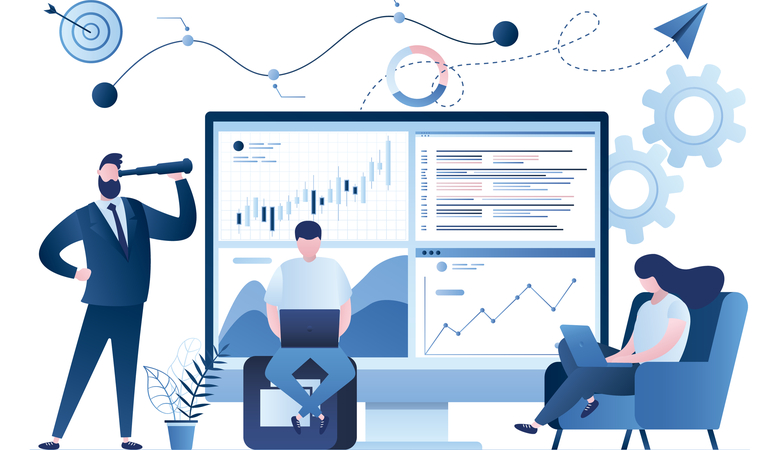Optimizing Workforce Forecasting for Business Success
Key Takeaways:
- Workforce forecasting helps businesses predict future labor needs.
- Accurate forecasting leads to improved productivity and cost efficiency.
- Incorporating technology simplifies the forecasting process.
- Practical steps and tools are available to enhance workforce forecasting accuracy.
Introduction to Workforce Forecasting
Workforce forecasting is a strategic approach to predicting future labor needs and is essential for effective business management. By accurately anticipating staffing requirements, companies can avoid overstaffing and understaffing, ultimately saving costs and enhancing overall efficiency. Understanding and implementing effective workforce forecasting is pivotal in today’s dynamic market environment. To make informed predictions, workforce forecasting involves analyzing data points, such as past employment trends, economic indicators, and organizational growth plansWorkforce forecasting involves analyzing data points, such as past employment trends, economic indicators, and organizational growth plans, to make informed predictions. In an era where agility and foresight determine success, workforce forecasting empowers businesses to stay ahead of demand, ensuring they have the right personnel at the right time.
Benefits of Accurate Workforce Forecasting
An effective workforce forecast drives multiple benefits:
Increased Productivity
By aligning workforce capacity with workload demands, businesses can ensure optimal productivity without overburdening employees. Proper forecasting helps distribute tasks more evenly, reducing the chances of burnout and increasing job satisfaction. When employees are neither overworked nor underutilized, their performance metrics improve significantly. This equitable division of labor promotes a happy workplace, which in turn raises employee enthusiasm and morale and may even lower turnover rates.
Cost-Efficiency
Reducing manpower costs while meeting business demands allows companies to allocate budgets more effectively. This prevents financial waste due to overstaffing. Conversely, it also helps avoid understaffing, which can lead to missed business opportunities and lower service quality. By maintaining an optimal workforce size, companies are able to manage payroll expenses more effectively while also having the flexibility to invest in other critical areas such as employee training, technology upgrades, and strategic initiatives.
Better Talent Management
Proactive workforce planning helps nurture and retain talent, aligning employee skills with future business requirements. This enables companies to focus on employee development, ensuring a continuous supply of skilled labor tailored to evolving business needs. For instance, if a company anticipates growth in a specific department, it can begin upskilling current employees, reducing the need for external hiring. This not only saves costs related to recruitment and onboarding but also fosters loyalty and engagement among existing employees.
Common Challenges in Workforce Forecasting
Despite its advantages, workforce forecasting presents several challenges:
Inaccurate Data
High-quality data is crucial for reliable forecasts. Only accurate or complete data can lead to good decision-making. Companies must invest in robust data collection and analysis tools to gather precise information for effective forecasting. Without accurate data, forecasts can skew results, leading to either overstaffing, which increases costs, or understaffing, which can hamper productivity and customer satisfaction. Maintaining data integrity through regular audits and validation processes is essential to ensure the reliability of the workforce forecasting models.
Rapid Market Changes
Market volatility can make long-term forecasting difficult, requiring agile and adaptive planning processes. Factors such as economic downturns, political instability, and technological advancements can quickly alter labor needs. Companies must, therefore, maintain forecasting flexibility, regularly revisiting and adjusting their models to align with shifting market conditions. Developing contingency plans to address sudden market shifts can also help companies remain resilient and avoid disruptions to their workforce plans.
Integration Issues
Integrating forecasting tools with existing systems can be complex, necessitating strong IT support and infrastructure. Ensuring that new software solutions are compatible with current HR and financial systems is essential to avoid data silos and streamline operations. Proper integration allows for seamless data flow and comprehensive analysis, optimizing the forecasting process. Companies must involve IT teams from the earliest stages of selecting and implementing new tools, ensuring all technical aspects are addressed and that new systems work harmoniously with existing infrastructure.
Modern Tools and Techniques
To overcome these challenges, businesses can leverage modern tools and techniques:
Software Solutions
Advanced software can efficiently manage and analyze workforce data, providing critical insights that manual methods cannot. Platforms that offer real-time data analytics and reporting capabilities empower managers to make data-driven decisions. Integrating AI and Machine Learning with forecasting software can further enhance the accuracy and efficiency of predictions. By leveraging these advanced tools, companies can streamline their forecasting processes, improve data accuracy, and gain deeper insights into their workforce needs. Implementing these technologies is particularly crucial in industries like real estate, where understanding and anticipating market trends can significantly impact success. The importance of Real Estate Agent CRM cannot be overstated, as it plays a vital role in managing client relationships and driving business growth.
Integrating AI and Machine Learning
Artificial Intelligence and Machine Learning enhance accuracy by identifying patterns and predicting future staffing needs. These technologies can analyze vast datasets quickly, providing actionable insights that help in making proactive decisions. They can also adapt to new data, continuously improving the forecasting process. For example, AI can analyze historical hiring data alongside current business trends to predict specific staffing requirements. At the same time, machine learning algorithms continuously refine and optimize these models as new data is integrated.
Utilizing External Data Sources
Integrating external data sources such as economic indicators and industry trends can provide a broader perspective. This outside information helps understand the larger market dynamics, making forecasts more robust and comprehensive. Using external data, such as demographic trends, wage growth, and unemployment rates, businesses can better predict future labor market conditions and adjust their workforce planning strategies accordingly. Using a comprehensive strategy guarantees that businesses are aware of external elements that may affect their employment demands in addition to relying just on internal data.
Practical Steps for Effective Forecasting
Adopting a structured approach can significantly enhance forecasting effectiveness:
Identify Key Metrics
Determine the critical metrics that impact your workforce needs, such as project timelines, seasonal demand, and employee turnover rates. Identifying these metrics allows businesses to focus on the most influential factors, leading to more accurate forecasts. By understanding which factors significantly impact staffing, companies can prioritize their data collection and analysis efforts to ensure they make informed decisions aligning with their business objectives.
Regular Data Analysis
Regularly review and analyze workforce data to stay aligned with current trends and make necessary adjustments promptly. This continual evaluation helps refine forecasting models and improve their reliability over time. Consistent data analysis enables companies to identify emerging trends and potential challenges early, allowing them to take corrective actions before issues escalate. Incorporating regular feedback loops into the forecasting process ensures that the models remain accurate and relevant as business needs evolve.
Engaging Stakeholders
Involve key stakeholders in forecasting to understand business needs and objectives comprehensively. Collaborating with various departments and team leaders ensures that the forecasts are aligned with the company’s goals and operational realities. By engaging stakeholders from different areas of the organization, companies can gather diverse perspectives, ensuring the forecasts are well-rounded and consider all facets of the business. This collaborative approach fosters buy-in and support for the workforce planning process, increasing its effectiveness and implementation success.
Future Trends in Workforce Forecasting
The realm of workforce forecasting continues to evolve, influenced by emerging trends such as:
Predictive Analytics
Predictive analytics tools are becoming more sophisticated, helping businesses accurately foresee and adapt to future staffing requirements. These tools use historical data and advanced algorithms to predict future workforce needs, enabling proactive planning. By leveraging predictive analytics, companies can identify potential talent shortages and succession plans and optimize workforce allocation. These insights help businesses stay agile and responsive in a constantly changing market environment.
AI-Driven Solutions
With AI, forecasting models continually learn and improve, resulting in more precise predictions and better outcomes. AI-driven solutions can quickly process large volumes of data, providing real-time insights and recommendations. For example, AI can analyze employee performance data, customer demand patterns, and other variables to predict staffing needs. It allows companies to adjust their workforce in real time to meet changing demands. This continuous improvement cycle ensures that forecasting models remain accurate and relevant, enhancing decision-making capabilities. Additionally, individuals can explore AI’s capabilities beyond forecasting by leveraging tools like try photo editing online to enhance creativity and productivity in various domains.
Gig Economy Impacts
The rise of the gig economy is reshaping the workforce landscape, as highlighted in Gig Economy Impacts, presenting new challenges and opportunities in workforce forecasting. As more workers engage in freelance and contract work, businesses must adapt their forecasting models to accommodate this flexible labor market. The gig economy offers companies access to a diverse pool of talent on demand, providing greater flexibility and cost savings. However, it also requires businesses to develop new strategies for managing and integrating gig workers into their workforce, ensuring consistency and quality in service delivery.
Conclusion
Effective workforce forecasting is indispensable for modern businesses striving for success. By understanding its benefits, navigating challenges, and leveraging modern tools, companies can optimize their workforce planning strategies and stay ahead in a competitive market. A robust forecasting process enhances operational efficiency and improves long-term business growth and employee satisfaction. As businesses adapt to changing market dynamics, workforce forecasting will remain critical to their strategic planning efforts, ensuring they have the right talent to achieve their goals and drive sustainable success.
Stay in touch to get more updates & news on Stylecarter !






